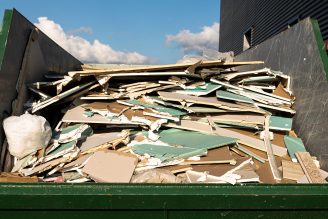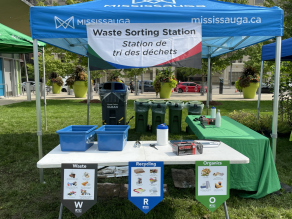Cutting down landfill waste – Mississauga’s move to curb excessive waste
The circular economy model focuses on repairing, repurposing and recycling items instead of throwing them out to help reduce the need for new materials, lower carbon emissions and conserve energy.
Environment | March 15, 2024
Did you know Ontarians send about 12 million tonnes of waste to landfills annually – that’s roughly around 2.2 kilograms (almost 5 pounds) of waste per person per day, according to the Ontario Waste Management Association. Many of these materials that end up as garbage could have been reused or recycled.
Municipalities like Mississauga are prioritizing programs and strategies that divert waste from landfills and are effectively looking for ways to reuse, recycle and manage used products and materials to extend their useful life.
Adding to the problem
Many of us are adding to a growing problem. Every time we dispose of something we no longer need, it ends up in a landfill. We’re essentially burying our waste. Waste can take many years to decompose. As some of these materials decompose, they release toxic chemicals and gases, like methane, a highly potent greenhouse gas that contributes to climate change. This, in turn, poses health risks to wildlife and humans.
Many items that end up in a landfill could have been reused or recycled. Currently, Ontario’s landfill capacity can only accommodate 13 more years of waste and they are filling up quickly.
Much of this waste is from construction, renovation and demolition where materials like wood, bricks, metal, cardboard, carpeting as well as furnishings can be reused or recycled. Although landfills are necessary for materials that cannot be reused or repurposed, a considerable amount of waste that ends up in landfills could have been salvaged.
The Circular Economy model
To reduce landfill waste, we can practise the circular economy approach. It aims to minimize waste by using items for as long as possible. The approach focuses on repairing, refurbishing, repurposing or recycling products and materials to create a system where nothing is wasted. Practising this approach helps reduce the need for new materials and helps lower carbon emissions and energy use. When we replace an item with something new, additional greenhouse gases are generated through the production, manufacturing and transportation of the item. Finding a new purpose for items and materials is a fundamental step towards supporting a circular economy.
City’s initiatives to divert waste
The City has undertaken several waste diversion projects over the past few years. During the renovation of the Hazel McCallion Central Library, more than 120,000 kilograms of materials were diverted from landfills. The Living Arts Centre recently completed a waste diversion project, successfully donating more than 4,000 kilograms of furniture such as chairs, tables, and benches. The City also diverted 1,900 kilograms of organic waste at the 2022 Ontario Summer Games and Ontario Parasport Games by setting up waste sorting stations at all participating cafeterias.
The City’s Corporate Green Building Standard is also applied to all new developments and major renovations at City facilities. It provides a comprehensive set of environmental performance requirements that establish the City as a leader in sustainable buildings in Canada. This includes reducing the amount of construction and demolition waste that is sent to landfills (currently requiring a 75 per cent diversion rate).
The City is working to reduce waste by developing plans and strategies that support the circular economy model. This includes the Climate Change Action Plan, Mississauga Economic Development Strategy 2020-2025 and the Smart Cities Master Plan.
The City will continue to look for ways to reduce waste, especially in these areas:
- Building efficiency
- Business engagement
- Economic development
- Education
- Food waste
- Retrofits
- Space planning
- Sustainable procurement
Reducing waste at home
If you want to practise the circular economy model at home, you can look for ways to extend the life of items by repairing, repurposing, reusing or recycling the items.
- Look for ways to repair or repurpose broken items. Mississauga Library has Makerspaces equipped with sewing machines, Cricut machines and 3D printers. You can learn to sew up a tear in your clothing or create a new textile. You can also create a design to stick onto a mug to make it new again or you can 3D print an item that you need for a repair.
- Donate furniture, electronics or clothing to family, friends, a local donation store or charities.
- Go paperless where possible. In today’s digital world, it’s easy to switch to paperless options for billing, receipts or other documents.
- Consider borrowing or renting less frequently used items like tools, party supplies and board games.
- Avoid single-use items by using your reusable beverage and food containers, cutlery, straws and bags instead.
- Divert fruit and vegetable scraps, eggshells, coffee grounds and other organics from landfill by placing them in your green bin.
Learn more about how Mississauga is leading climate change efforts and other environmental sustainability initiatives through the Climate Change Action Plan and ownyourlitter.ca.
Tags
Media contact
City of Mississauga Media Relations
media@mississauga.ca
905-615-3200, ext. 5232
TTY: 905-896-5151



